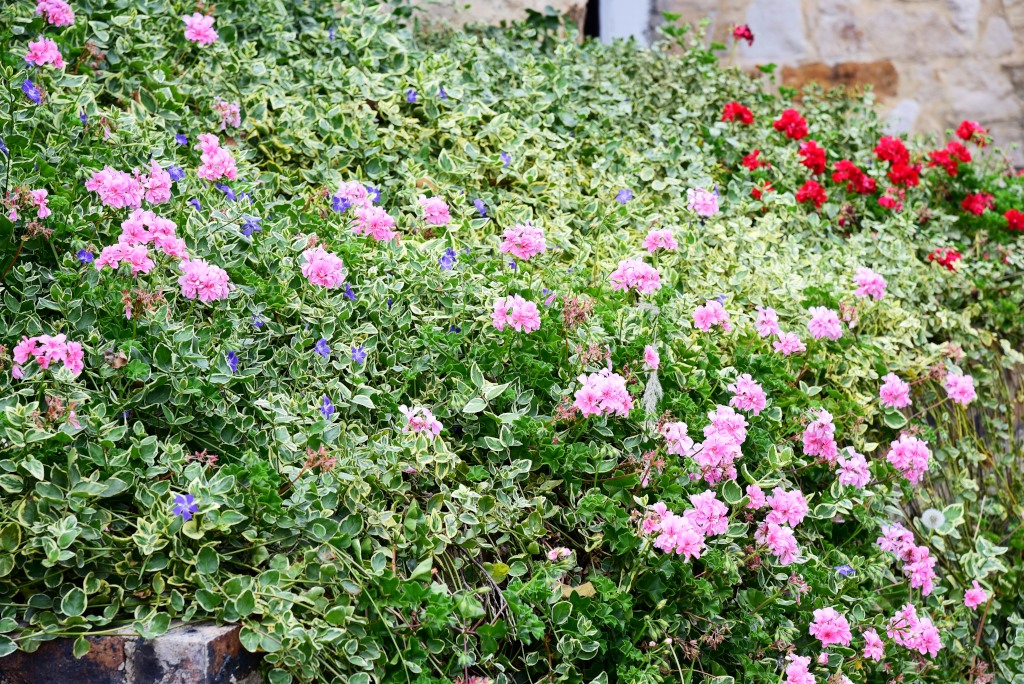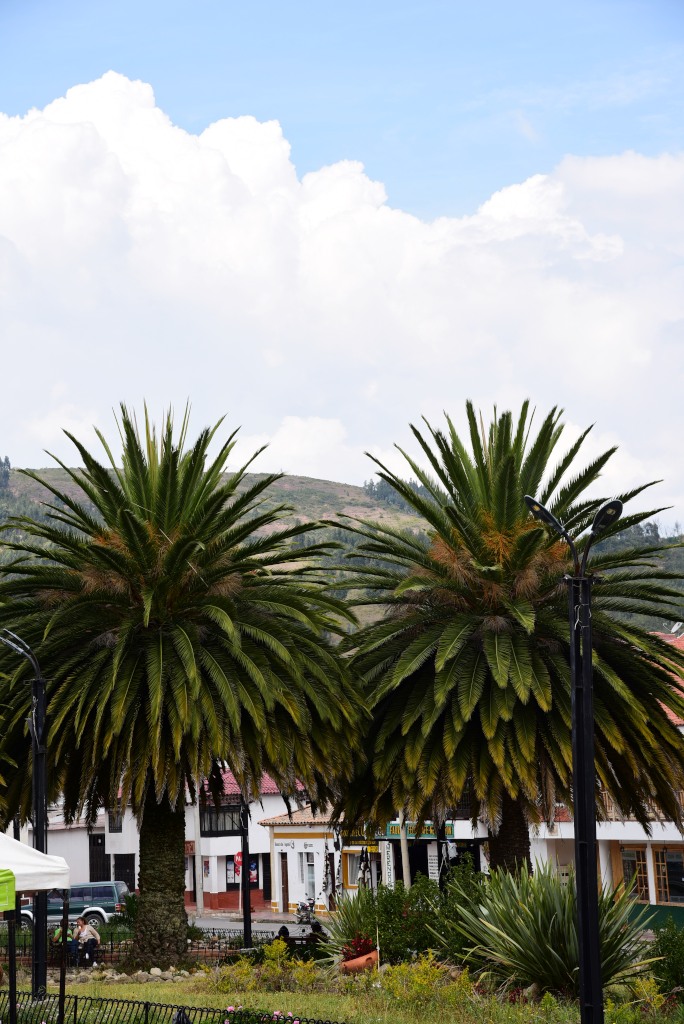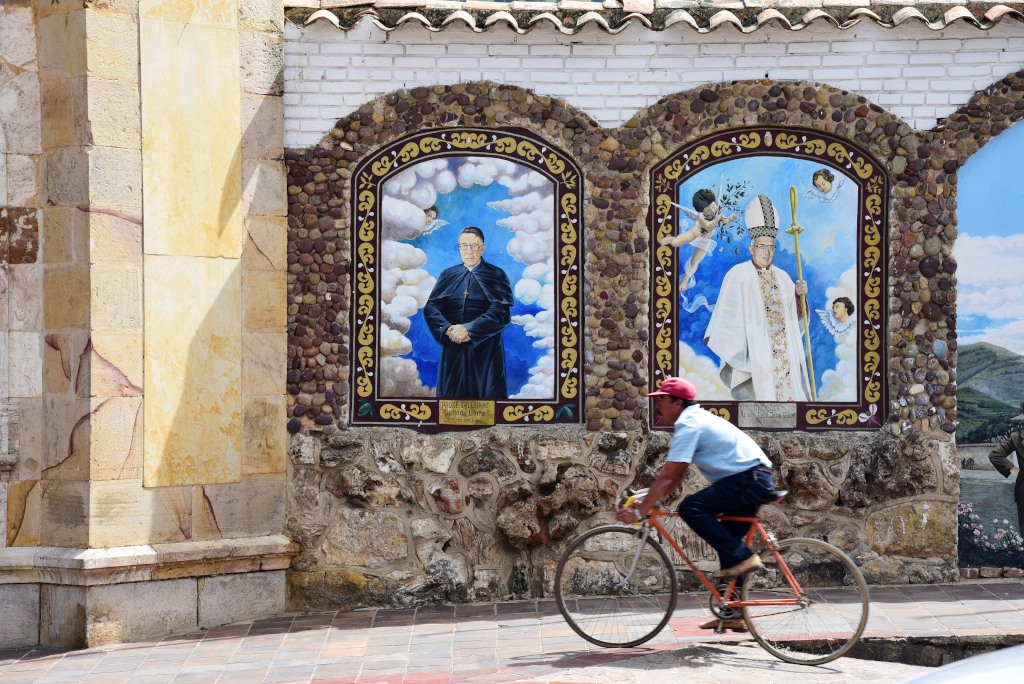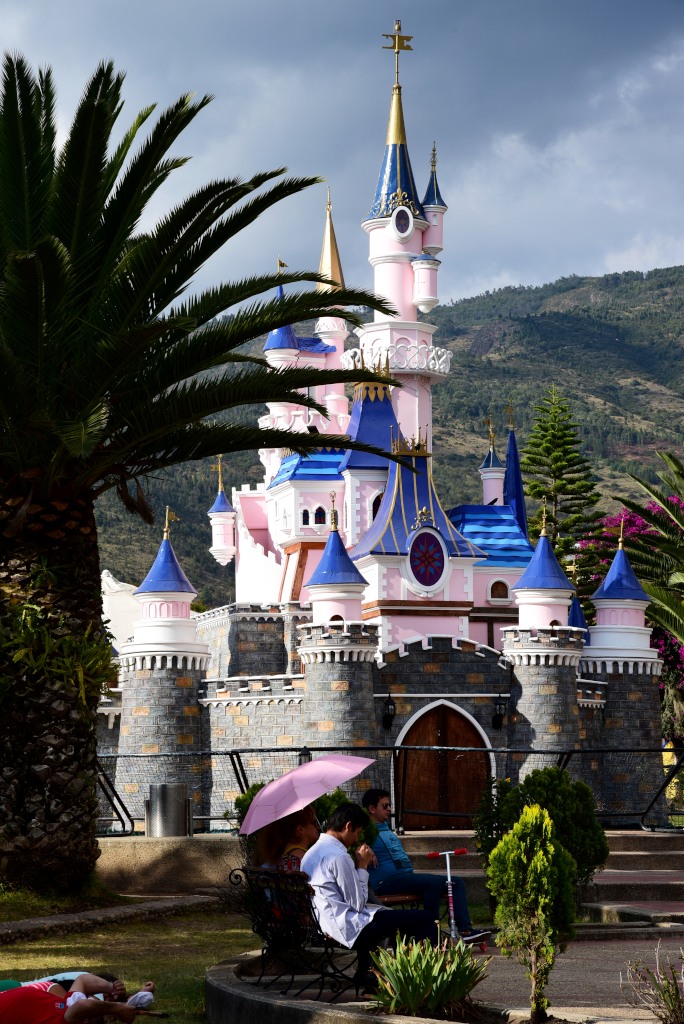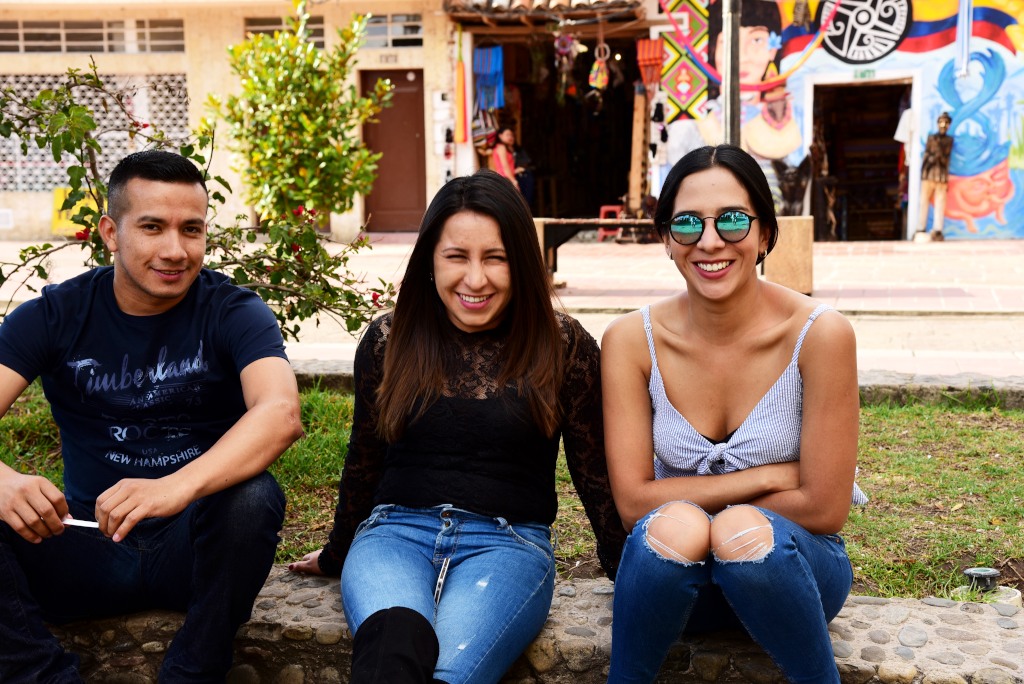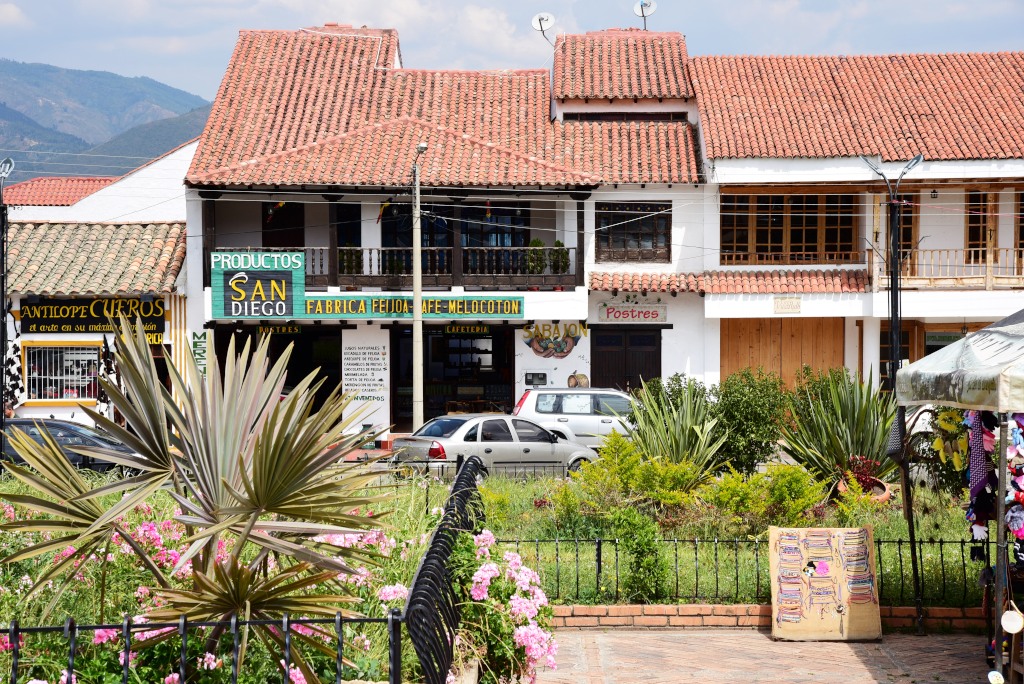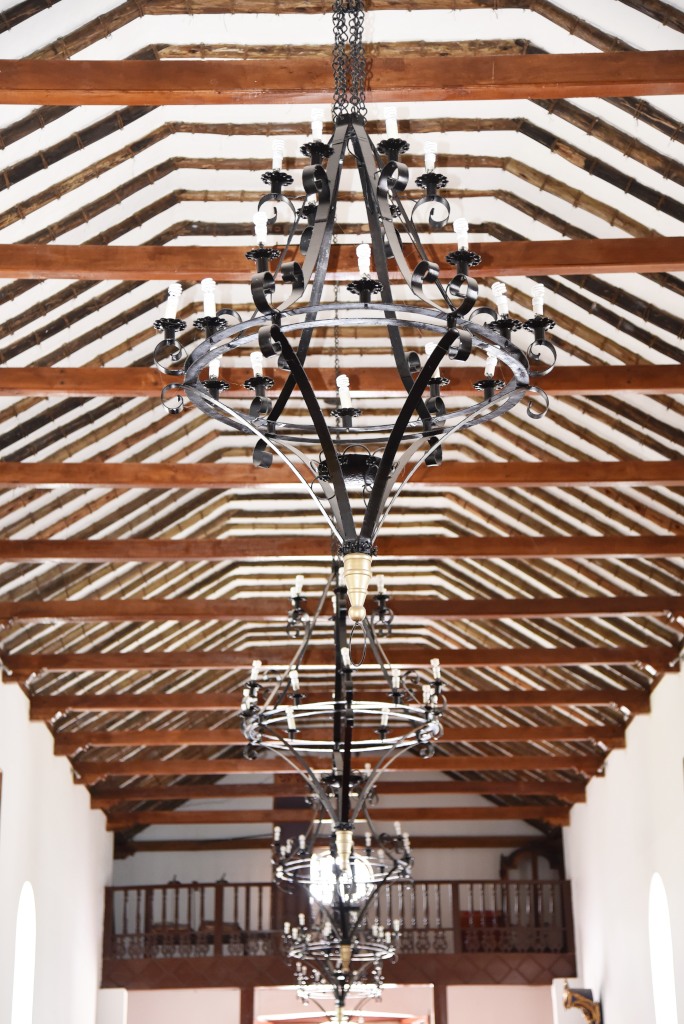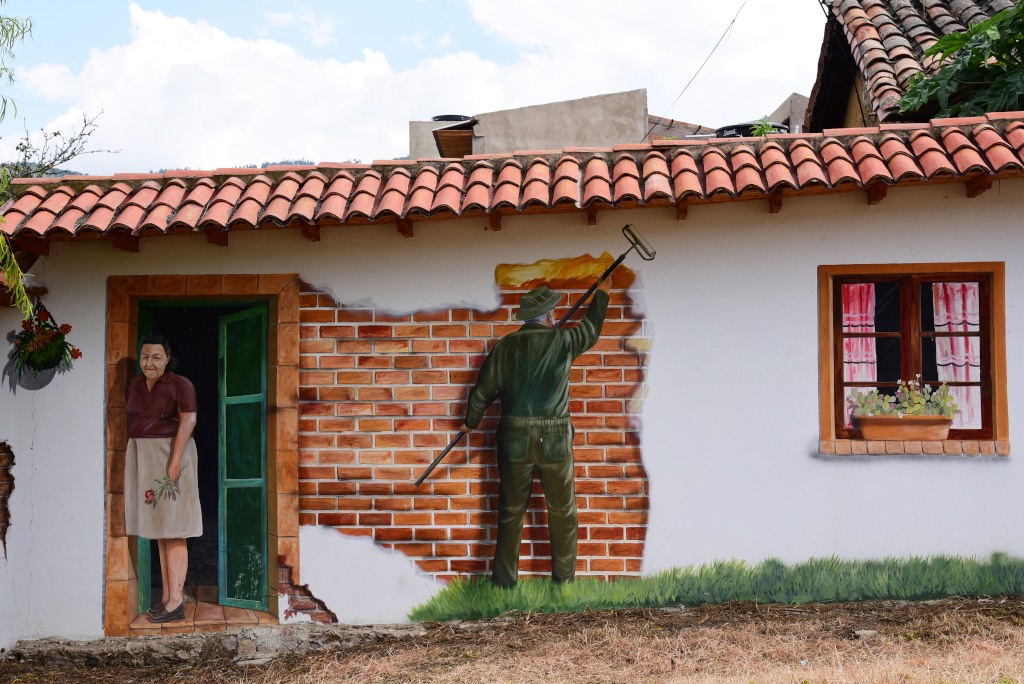February 4th, 2018
The morning is spent writing and listening to the rock music pumping through the windows from … where exactly, I am not sure exactly. Does Sogamoso celebrate its Sunday service with rock music?
While I get a fair amount done in the morning, I am obviously also sacrificing the entire morning for an activity that detracts from the experiences I should actually be making.
Back to the same tipico restaurant I had dinner yesterday evening, for the identical breakfast offered everywhere else, caldo de costilla, hot chocolate, a roll and huevos pericos. A minor note – somehow the pericos don’t taste that great, and I suspect that oil or fat may have been added to make them blander. Or little onion is used, reflecting the Colombian aversion to spice.
It turns out that the few tipico restaurants in the central area belong to the women’s family. The place I went to yesterday morning belongs to her son. But I should come to her place, as she has a far greater variety. My coming to the family outfit is a source of entertainment for her and her employees.
Traffic heading north on Carrera 11 on the west side of the plaza is rich in bicycle traffic, and the great thing is that the cyclists are diverse, from workers on dilapidated bikes, boys on low riders, young men with their girlfriends riding in front, young men with their male friends riding in front, and cyclists on racing bikes in jerseys and lycra shorts.
On the plaza, exhausted ice cream salesmen push their little red carts, although the good thing is that there are a lot of locals meandering around the plaza and the streets eating ice cream this time of day. I am in fact one of the few people that is not!
Older people are seated in the growing heat on the park benches, shoe shine men busy with their trade. A few errant individuals look at me suspiciously, and possibly not with the best of intentions, which is why I walk as fast as possible.
The Trigos outlet on the main plaza is hardly that impressive, certainly not as nice or modern as some of the other outlets. It turns out that there are two other very nice pastelerias around the corner, and on the opposite side of the plaza, the other two that I discovered on Calle 11 yesterday evening. Not that I should be going near these places to begin with.
I board a city bus at 12th and 12th with destination of the bus terminal. The system for taking buses to the small towns in the region is easy, as all the short haul buses gather in the same corner of the terminal, with the destinations printed clearly on placards displayed in the windows. Conveniently, the buses to the small towns also leave frequently.
A bunch of transvestites walk by outside the terminal to the raised eyes of locals. Is there something about Sogamoso I didn’t know?
The buseta trundles through the suburbs of Sogamoso, increasingly palatable as we are further out of town, although nevertheless on the bleak side. A few blocks here and there with smart shops, a park, local citizens performing their Sunday walkabout adding to the ambiance.
We take the highway towards Duitama, which is even largely than Sogamoso. Cyclists on racing bikes ride single file in the opposing direction. Soon after having reached the highway, we turn off onto the long road running up to Tibasosa’s main square.
Tibasosa brings the notion of a character town to a new level of meaning. The broad plaza is dominated by the free-standing twin-spired cathedral, and ringed by coherent two-level adobe-and-terracotta Spanish architecture. Narrow second-floor wooden verandas line the second floors of buildings, with wooden doors at regular intervals on both levels.
The bulky Canary Island date palms that lend so much drama to other towns are also well-represented here. Flowering bushes and trees are ubiquitous, and the blue skies and bright sunlight bring the town’s beauty to even greater heights. The plaza is ringed by cafes.
Vendors sell local food products in tents. One woman catches my attention with her bags of quinoa granola, local honey, and bagged oca. She was apparently one of the first quinoa growers here some 27 years ago, and has been pushing the grain, particularly farmed organically, ever since.
It is very much an uphill battle for her, and yet there has been a growing acceptance over the years. Yet alternate products, particularly organically farmed ones, stand little chance of seriously impacting the ubiquitous onion crops in the region. The oca I have seen elsewhere, just not realized what it was.
Tibasosa is definitely a tourist destination, not just for locals but also foreigners. It is too coherently classy to not be a destination, although there are few visitors currently present.
I speak with a taxi driver sitting on a bench, asking him how is it that this town can appear so immaculate, while Sogamoso such a mess? He tells me something that hardly comes as a surprise – the city of Sogamoso only cares about money, and has poor administration. The city is totally polluted and the administration engages in no planning, hence the chaotic look of the city. Nor do the citizens care, as they just want to make as much money as possible.
I meet a group of cyclists wearing jerseys and lycra shorts seated on their racing bikes at an intersection. They are based in this town and often travel in groups, selecting routes depending on the degree of challenge they decide to take on. Obviously, that can vary dramatically. I thank them effusively for their time and give them encouragement, and then they are off again.
Walking along an alley a few blocks from the plaza, I pass an older model red car parked diagonally across the street, the sound system blaring some old Discos Fuentes classics which sound a lot like Fruko y sus Tesos.
Tableaux are painted on the walls radiating around the cathedral. A man cycles on an old 10-speed to the church as I walk inside and peer into the gloom. Hefty wrought iron chandeliers are suspended from the ceiling at regular intervals. A gilt crest with florettes separates the altar from the nave, the altarpiece three levels, with coffers for each saint, pillars delineating the coffers, the entire piece gilt, in a manner typical for the altarpieces I have seen thus far in Boyacá.
Stray dogs abound in Tibasosa, although I have never felt any aggression from dogs here, or in any town for that matter. It would seem that the dogs may not be stray, simply left to their devices to run around town and entertain themselves. If anything, dogs may react fearfully to an unknown person, or in a friendly manner if given the opportunity.
There are so many properties for sale in town. I wonder if it is in response to something bad happening, or simply the realization the town is one of the most desirable towns in the area, and that potential investors are beginning to focus their money here.
In the case of Tibasosa, it isn’t just the main square that is stunning, but the blocks radiating out from the main square, in the same manner as Villa de Leyva, only much more intimate. I pass whimsical displays of flowers, intimate restaurants, small bridges, wall murals, the green mountains surging behind the village on all sides. On the highway side, a series of posh restaurants that would be expected near the plaza in Villa de Leyva appear, although the prices are high enough to drive me away, but more because I have little confidence in Colombian culinary talents, irrespective of the price tag.
Waiting for the buseta outside the station in Sagamoso for Nobsa, the sun is now moving into the late afternoon. I am concerned that I may not make the last bus back from Nobsa, but then there is so much bus service here. That said, I should really try and spend my last day in the area being more active, doing sightseeing from the morning onwards, and not from the early afternoon. Such are the travails of a writer …

Weaving through the suburbs of Sogamoso again, we remain on a local road, even as the last tendrils of the towns suburbs dissipate, and then soon after turn onto a smart side road, curving uphill towards Nobsa, and passing a huge cement factory, which is presumably one of the area’s big employers.
The van passes some four blocks of storefronts with wool ponchos on display, but as I later find out by randomly touching the material as I walk by, it is all the same coarse, low quality material.
On occasion there are intriguing designs, but beyond being incredibly uncomfortable to wear, the material would succumb rapidly to moth infestations.
The main square is beholden to a festive family setting, as opposed to Tibasosa’s evocative serenity. The same essential components are in place, a towering cathedral, historic and aesthetically coherent architecture surrounding the plaza, the bulky Canary Island date palms, trimmed hedges and copious flowers. Every bench and grassy surface is inhabited by families with children, young couples, and the elderly, enjoying the sunny afternoon in their town.
Collapsible play structures have been set up to occupy the children on the walkways around the plaza. The crowning achievement is the miniature Disney castle in the centre, with figures of Snow White and Captain America standing on a podium nearby.
At the corner nearest the cathedral, a young man with a collection of spray paint cans and samples of his work laid out before him has attracted quite the crowd, spraying onto the paper deftly as he holds the people in rapture with his monologue. The quality of his work leaves a lot to be desired, but in the likes of Nobsa, there is hardly much competition.
Life-size metal sculptures of musicians playing various instruments are installed at intervals around the periphery of the plaza. The sculptures appear to be constructed from scrap metal, without any application of paint or finishing, rust instead used to achieve the effect of colour. As elsewhere, a number of evocative establishments cater to visitors on the street level as well as the upper floors of cafés in the buildings lining the plaza.
The surrounding blocks are nowhere nearly as interesting and appealing as in Tibasosa, but nonetheless. Modest single or two-level houses with little sign of life, no traffic, and at the end of one street, a staircase leads up a small hill to a blue-and-white chapel. En route, a small graveyard, where I help a man water the flowers on an upper tier of the columbarium where the deceased relative’s ashes are presumably stored. He is grateful, but also confused as to what I would be doing here.
Further down, a modest canal that flows down from the area of a small stadium, the channel nested in a belt of green, with modest trees, bright yellow metal fencing and flowering shrubs defining the aesthetics of the area.
A family is seated around the miniscule stoop of their house, the car parked in front blaring salsa, portraying quite the counterpoint to the drab cinder block houses that line the street.
Entering Sogamoso again in the late afternoon, I have a more forgiving view of the neighborhoods, some looking acceptable, with relatively new well-kept houses, the neighborhoods strung along from the outskirts into the centre of town. What definitely seems missing is wider sidewalks, a better degree of maintenance, yards of any sort, and a green canopy running along the sidewalks.
In the neighborhood of the bus station, I ask the bus driver if we are near downtown. Yes, near downtown as well as the bus station. All I need to do is walk to our left, where the centre is located, while the bus station is located on the right. And now it occurs to me – I had walked east along Calle 11 yesterday, and I should never have turned off the street, as I did and got lost.
I continue on Calle 11 today towards the plaza, then through the late afternoon crowds to my hotel, but not before consuming another arepa de mazorca from the same vendor as yesterday.
It turns out that the young women working in the hotel like slaves are just substituting for the administrator who is on vacation at the moment. One is about to enter law school, which is an undergraduate degree in Colombia. She will study in Tunja, and does not want to move to Bogotá, as life in the city is too stressful, what with the lengthy travel requirements. Tunja would suit her fine, as it is a small city and very compact. Her sister is studying general technology, which will get her into any computer-related field, and is already well underway in her studies.

I had planned on visiting the gym in Sogamoso, but whenever I plan on going, they all seem to be closed. My body is showing the effects of a lazier lifestyle, in particular, the heavier meals and starch that make up my diet here.
I suspect that there could be more to Carrera 11 that meets the eye – that is, than delimited by the Plaza 6 de Septiembre – and lo and behold, when I map pizza places in Sogamoso, a crop appear along Carrera 11 further to the north. I am now motivated to discover another side of Sogamoso that I would never have suspected ..
The street at this time of day has somewhat of a noir feeling, illuminated by street lights and the odd light on buildings, but then the occasional trendy cafe and restaurant brings the street to life. A bicycle path is incorporated into the wide sidewalk, the pedestrian portion occupied by straggling crowds of youth. Upon closer inspection, the restaurants are a somewhat different affair, mostly just pizza and burger joints.
With pizza the following issues arise almost universally: poor understanding of preparing the crust, inappropriate combination of ingredients, wrong cheese (Colombian cheese is of rock bottom quality – I can’t imagine what it would be appropriate for other than not using at all), and no flavour whatsoever.
The burgers, well, I am about to find out. At one of the places that beckons on Calle 11, Brangus Burgers, I order the most expensive one and hope for the best. The burger arrives in a big stack, which I promptly dissect. The bun – no, mushy white bread is not appropriate here, and even if that is what you decided to use, you could have toasted it.
The burger: the patty is rough, the meat poorly ground, and with gristle. The ham and cheese are the low quality dross that Colombians use that should certainly not be used in an expensive burger such as this. There is a patty of what looks like arepa, which is simply wrong in a burger. I eat it and yet don’t feel like having to rid my body of it after the fact, which I think is a major accomplishment.
I return onto the street and find it empty except for a few dodgy characters. I am tall and walk fast, but nonetheless, in the absence of any presence of police or public, the streets assume a different nature. I pay particular attention to the few establishments that are still open that I pass by, as they represent potential safe zones.










